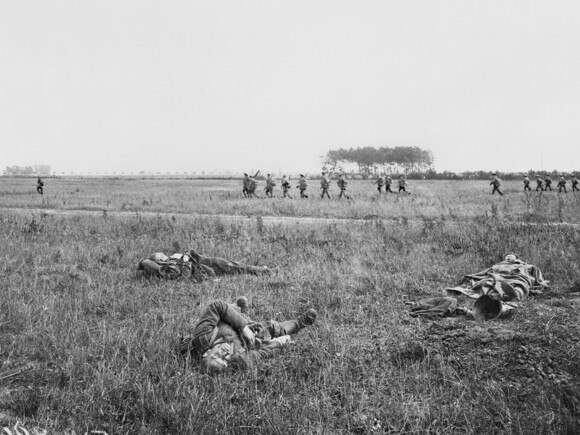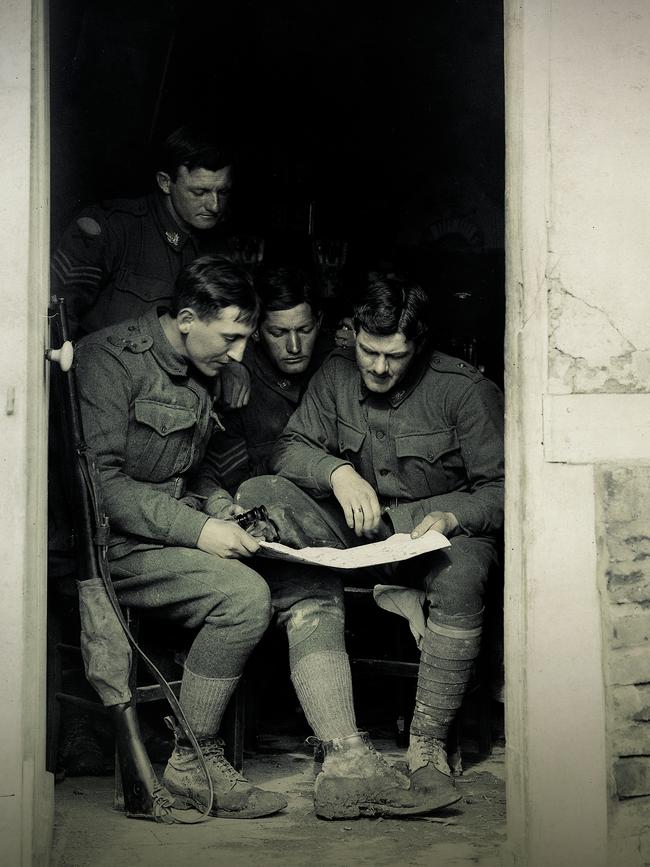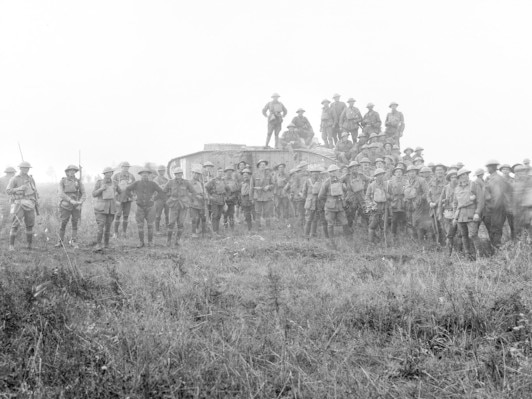World War I: Australian victory at Amiens marked the start of the end for Germany
An Australian victory at Amiens 100 years ago marked the beginning of the end for the military might of Germany.

Corporal Walter Downing of the 57th Battalion was among the thousands of Australian troops laying out in position near the town of Villers-Bretonneux in France in the early hours of August 8, 1918. At precisely 4.20am, the fire of hundreds of artillery guns erupted in unison, shattering the silent hours before daybreak.
“It was as though a flaming dawn had been flung into the sky,” he said. “The whole world flared behind us … white smoke curled over us and hid the flaming skies.”
The bombardment screened the assaulting waves of infantrymen from the 2nd Australian Division as they went into action, blanketed by thick fog. “There was a thrumming as of gigantic bumble bees, and low chug-chug-chug, as the ugly noses of the tanks poked through the mist above us … Then a rattling of machineguns told us that the lads in front were at grips with the enemy.”
Downing was a participant in and witness to one of the most significant actions fought by British and dominion forces on the Western Front. In a matter of hours British, Australian, Canadian and French troops advanced with hundreds of tanks. Supported by aircraft and an enormous amount of firepower they tore a gaping hole in the German Army’s defences south of the Somme River.
The Australians and Canadians advanced 12km into German-occupied territory, ― the longest single advance achieved on the Western Front in one day.
Those who followed in the wake of the assaulting infantry were stunned to see horse-drawn field artillery galloping into action, and cooks from battalion transport sections boiling the pot on field cookers as they shuffled forward into enemy territory.
By 1pm, all four Australian divisions involved in the fighting had taken their objectives in an attack described by one of its commanders as “the most bloodless ever made by Australian infantry in a great battle”. For the loss of 2000 dead and wounded (heavy enough in human misery but astonishingly light given the number of troops involved) the Australian Corps under the command of Lieutenant General Sir John Monash succeeded in capturing 7200 prisoners, 173 field and heavy guns (including a large 28cm rail gun that lobbed 240kg shells 20km into Allied territory) and enough engineering material to sustain it for the rest of the war. It was a watershed moment in the fighting on the Western Front. German general Erich Ludendorff described August 8, 1918, as “the black day of the German Army”.
What made the battle of Amiens such a resounding success was the important tactical lessons that had been demonstrated weeks earlier. On July 4, Australian and some American troops under Monash’s command carried out a successful attack at the village of Le Hamel in an effort to straighten a bend in the Australian Corps front. The Allies knew the morale of the German troops opposite them was low and their defences were incredibly poor, and the Hamel battle plan stressed the element of surprise and a ground attack with clearly defined objectives 2km away.

With infantry, tanks, aircraft and an enormous amount of artillery at his disposal, Monash had the good fortune of commanding a recognisably integrated weapons system that characterised much of the fighting in the final months of the war. He famously likened this all-arms battle to a symphony, with himself as conductor: “A perfect modern battle plan is nothing so much as a score for an orchestral composition, where the various arms and units are the instruments, and the tasks they perform are their respectful musical phrases. Every individual unit must take its entry precisely at the proper moment, and play its phrase in the general harmony.”
Hamel was not a blitzkrieg battle, as often has been claimed, but an attack with limited objectives that ensured assaulting troops possessed every technological and tactical advantage possible. Nor did Monash invent the tactics used at Hamel, as has been claimed also: he was a very fine and capable commander willing to tap the rich vein of tactical learning and development that the broader British Army had refined during four years of fighting. A methodical planner, Monash learned from the latest British attack doctrine, ideas and new technologies based on the successes and failures of previous engagements. He also planned the operation fastidiously, holding lengthy conferences in which the commanders and experts whose units were involved were encouraged to pool ideas so potential problems could be foreseen and solutions considered.
The Germans defending positions at Hamel were caught completely by surprise, and assaulting units were on their objectives within a mere 93 minutes. Hamel was a practical demonstration of the benefits of assaulting German positions using combined arms tactics — a success Monash attributed to the “perfection of teamwork” — but its scale paled in comparison to what was achieved by British Fourth Army on August 8, 1918. Hamel was an attack along a 6km front, involving about 7000 Australian and American infantry, 60 British tanks, 639 artillery pieces and more 230 predominantly British aircraft.
The battle of Amiens, however, involved more than 100,000 infantrymen, 552 tanks (every tank available to the British Army), 782 aircraft and 1236 guns firing somewhere in the region of 350,000 shells across a 20km front. Under-strength and unable to resist such a ferocious arsenal of weaponry, the demoralised Germans south of the Somme River were at a huge disadvantage when faced by Canadian and Australian infantry coming at them through the fog supported by tanks. Downing described how “whenever we found ourselves in trouble we signalled to the tanks, and they turned on the obstacle. Then punk-crash, punk-crash! … Another German post was blown to pieces.”
After the war, Monash claimed he repeatedly insisted to General Sir Henry Rawlinson, the commander of British Fourth Army, the necessity of carrying out a combined arms attack on a much larger scale, since Australian patrols carried out after Hamel confirmed that the German formations opposite them had done nothing to strengthen their defences in the area. If the front held by the Australians could be reduced, and with support from the Canadians on their right, Monash was sure he could exploit the situation in the area and achieve a stunning breakthrough.

Monash felt he had been the prime mover behind Fourth Army’s victory of August 8, 1918, and there is no doubt the battle plan for Amiens was Hamel on a much larger scale. But as a corps commander, Monash was removed from the higher strategic direction of the war and was unaware that plans for a major Allied counter-offensive were already in motion at the higher command echelons. As Charles Bean wrote in The Official History of Australia in the War of 1914-1918: “Monash did not devise the August offensive, though of course he was responsible for many of the details of the plan for his own Corps.”
An important aspect of Monash’s battle planning for August 8 was setting limited objectives so his troops did not advance beyond their protective artillery screen. This involved a complex leapfrogging manoeuvre; infantry and field artillery of the 4th and 5th Australian Divisions would pass through ground captured by the 3rd and 2nd Australian divisions, which had instructions to dig in after securing their assigned objectives.
Seeing the Australians were ascendant in the Hamel area, and that the terrain was suited for tanks, Rawlinson resurrected plans for a major attack south of the Somme River that would become the battle of Amiens. The broader strategic vision of Allied commanders involved the French striking on the Marne, the Americans hitting the Germans southeast of Verdun, and the British leading the combined Anglo-French attack east of Amiens. Rawlinson’s Fourth Army would attack along a 20km front, with the Australians and Canadians attacking south of the Somme River with flanking support from the British and the French.
The broader strategic planning for the counter-offensive on the Somme was helped along by the real turning point of the war, which occurred at Soissons on the Marne River. On July 18, French Tenth and Sixth armies blunted the last major German thrust of their devastating spring offensive before launching an immediate counter-offensive with support from tanks, artillery aircraft and two of the enormous American divisions backed by more than 10,000 guns and 350 tanks. Advancing 10km in a single day, they succeeded in capturing more than 25,000 prisoners and 400 guns. It was clear by this stage the war had turned in the Allies’ favour, and that the German Army was on the steady road to defeat. Three weeks later, on August 8, hundreds of guns fired the intense bombardment screening masses of British, Australian, Canadian and French infantry supported by hundreds of tanks and scores of aircraft.
Their success was the right cross of a devastating one-two combination that sent the German Army staggering backwards on its heels. The battle of Amiens heralded the start of what has become known as the Hundred Days offensive — a confounding series of British and French attacks that drove the German Army back to its last defensive positions on the Western Front. As part of British Fourth Army, Monash led the Australian Corps through its most successful actions of the war, which included the capture of Mont St Quentin and Peronne, and breaching the Hindenburg Line at Bellenglise. But victory came at a heavy price, with the Australian Corps suffering 35,000 casualties under Monash in the four months between Hamel and the last Australian infantry action of the war at Montbrehain on October 5, 1918. After five months of hard fighting without relief, the Australian Corps was resting when the Armistice was signed on November 11, signifying imperial Germany’s formal defeat and an end to four years of slaughter. By then the Australian Imperial Force had suffered more than 179,530 battle casualties fighting in France and Belgium, which included 45,000 dead.
Downing went into action on August 8 with other units of the 5th Australian Division, leapfrogging other Australian units to capture the eastern side of the village of Harbonnieres. Troops of the 1st Australian Division passed through their position later that afternoon to assault the town of Lihons. Downing recalled seeing them in the distance, advancing towards the next line of German positions in short rushes with rifles and bayonet. The war was no longer a stalemate, fought from muddy trenches relentlessly shelled by German artillery, but was now a war of movement, fought through fields of wheat and corn with an impressive arsenal of supporting weaponry. The rattle of rifle fire echoed beyond the next ridgeline. “Batches of prisoners shambled through. Motor ambulances rolled along the road by our trench as the sun was setting. A frog croaked from a weedy ditch. A bird began its song.”
Aaron Pegram is a senior historian in the military history section at the Australian War Memorial.
